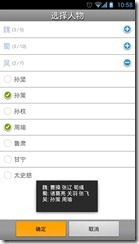二级菜单展开选择列表内容
声明:博文为原创,文章内容为,效果展示,思路阐述,及代码片段。
转载请保留原文出处“http://my.oschina.net/gluoyer/blog”,谢谢!
您可以到博客的“友情链接”中,“程序猿媛(最新下载)*.*”下载最新版本,持续更新!当前版本,也可直接点击“当前1.2版本”下载。
本文介绍,利用ExpandableListView列表展示,并可选择各个列表项。
首先,看下实现效果:
下面,介绍实现关键步骤,
代码里主要自定义了ExpListAdapter,继承自BaseExpandableListAdapter。里面会需要重写一些方法。需要重写的方法很多,其关键:
是构造方法中数据的创建;
组项在getGroupView中的更新;
二级列表在getChildView中的更新。
另外,可以关注的方法有:
点击组项,列表展开事件的处理;
以及,子列表项点击事件的设置。
下面,依次介绍:
-
在构造方法中,创建数据
因为只是思路的阐述,这里使用了固定数据做演示:
// 在array.xml中定义了子列表的数组
private int[] childResIds = new int[] {
R.array.array_explist_child_wei_name,
R.array.array_explist_child_shu_name,
R.array.array_explist_child_wu_name
};
// 存储组数据
private ArrayList<SelectChildData> list;
// 记录选择的子项
private HashMap<Integer, HashSet<Integer>> mSelectIds;
@SuppressLint("UseSparseArrays")
public ExpListAdapter() {
mSelectIds = new HashMap<Integer, HashSet<Integer>>();
list = new ArrayList<SelectChildData>();
String[] parent = getResources().getStringArray(R.array.array_explist_title_name);
getResources().getStringArray(R.array.array_explist_child_wei_name);
for(int i=0, size=parent.length; i<size; i++) {
SelectChildData p = new SelectChildData();
String[] child = getResources().getStringArray(childResIds[i]);
ArrayList<SelectChildData> cl = new ArrayList<SelectChildData>();
for(int j=0, len=child.length; j<len; j++) {
SelectChildData c = new SelectChildData();
c.id = j;
c.name = child[j];
cl.add(c);
}
p.id = i;
p.name = parent[i];
p.children = cl;
list.add(p);
mSelectIds.put(i, new HashSet<Integer>());
}
}如果需要是动态数据的话,在构造方法中,只进行成员变量的创建,不赋值。在需要的时候,通过方法调用进行动态添加即可,请根据实际使用情况扩展,不赘述!
-
组数据在getGroupView中的更新
其中,主要是布局的加载,和数据的设置,代码如下:
@Override
public View getGroupView(int groupPosition, boolean isExpanded,
View convertView, ViewGroup parent) {
// 加载组布局,获取内容
GroupViewHolder holder;
if(null == convertView) {
convertView = View.inflate(ExpListSelectActivity.this, R.layout.explist_group_item, null);
holder = new GroupViewHolder();
holder.mTitle = (TextView) convertView.findViewById(R.id.explist_group_title);
holder.mSelNum = (TextView) convertView.findViewById(R.id.explist_group_selected_num);
holder.mIndicator = (ImageView) convertView.findViewById(R.id.explist_group_indicator);
convertView.setTag(holder);
} else {
holder = (GroupViewHolder) convertView.getTag();
}
// 获取数据
SelectChildData data = (SelectChildData) getGroup(groupPosition);
// 标题设置
holder.mTitle.setText(data.name);
// 当前选择内容数量,和总数,显示如:(1/10)
ArrayList<SelectChildData>list = data.children;
int cnt = 0, num = 0;
if(null != list && !list.isEmpty()) {
HashSet<Integer> cids = mSelectIds.get(groupPosition);
for(SelectChildData d : list) {
if(cids.contains(d.id)) {
num ++;
}
}
cnt = list.size();
}
holder.mSelNum.setText(
String.format(getResources().getString(R.string.str_trans_receiver_num), num, cnt));
// 设置右侧显示图标
if(isExpanded) {
holder.mIndicator.setImageResource(R.drawable.icon_sub);
convertView.setSelected(true);
} else {
holder.mIndicator.setImageResource(R.drawable.icon_add);
convertView.setSelected(false);
}
return convertView;
}
-
二级列表在getChildView中的更新
同组数据类似,主要也是布局的加载,和数据的设置,限于版面,就不贴代码了,请需要的猿媛下载查看源码。
-
点击组项,列表展开事件的处理
在这里,我是在点击某项展开的时候,将展开的项进行了收缩,处理如下:
@Override
public void onGroupExpanded(int groupPosition) {
// mExpListView 是列表实例,通过判断它的状态,关闭已经展开的。
for(int i=0, cnt=getGroupCount(); i<cnt; i++) {
if(groupPosition != i && mExpListView.isGroupExpanded(i)) {
mExpListView.collapseGroup(i);
}
}
super.onGroupExpanded(groupPosition);
}-
子列表项点击事件的设置
代码中,定义了子列表项点击监听,在里面更新选择子项的内容记录。
// 定义监听事件,子列表项点击后,调用Adapter的方法进行更新
private OnChildClickListener mOnChildClickListener = new OnChildClickListener() {
@Override
public boolean onChildClick(ExpandableListView parent, View v,
int groupPosition, int childPosition, long id) {
mExpListAdapter.onChildClick(groupPosition, childPosition);
return true;
}
};
// Adapter中的子列表项点击处理方法
// 根据列表自身特性,通过从0开始的位置,作为key进行记录
public void onChildClick(int groupPosition, int childPosition) {
HashSet<Integer> children = mSelectIds.get(groupPosition);
if(children.contains(childPosition)) {
children.remove(childPosition);
} else {
children.add(childPosition);
}
notifyDataSetChanged();
}最后,可以在文初的截图中看到,点击“确定”按钮,通过Toast显示了选择的内容,获取内容的方法在ExpListAdapter中定义,主要是对记录的内容进行了拼接,如下:
public String getSelectInfo() {
StringBuilder s = new StringBuilder();
for(int i=0, size=mSelectIds.size(); i<size; i++) {
HashSet<Integer> children = mSelectIds.get(i);
// 记录不为空,则遍历列表去查找。
if(!children.isEmpty()) {
s.append(list.get(i).name);
s.append(": ");
ArrayList<SelectChildData> cl = list.get(i).children;
for(int j=0, len=cl.size(); j<len; j++) {
if(children.contains(cl.get(j).id)) {
s.append(cl.get(j).name);
s.append(" ");
}
}
s.append("\n");
}
}
if(s.length() > 0) {
return s.toString();
} else {
return "No Selection";
}
}Ok,基本点就这些了,应用安装后的源码获取,及获取后文件结构的情况,可以参考“程序猿媛”系列博文的第一篇:Android滑动翻页+区域点击事件
转载请保留原文地址“http://my.oschina.net/gluoyer/blog/176925”,谢谢!
您可以到博客的“友情链接”中,“程序猿媛(最新下载)*.*”下载最新版本,持续更新!当前版本,也可直接点击“当前1.2版本”下载。
来源:oschina
链接:https://my.oschina.net/u/991196/blog/176925


